Nursing Care for Falls Patients
VerifiedAdded on 2023/06/07
|12
|4008
|54
AI Summary
This article discusses nursing care for falls patients, with a focus on osteoporosis, neck of femur fracture, and wound healing. It also covers communication and person-centered care, maintaining a safe environment, mobility, and sleeping. The article provides practical tips for caregivers to ensure the safety and well-being of patients.
Contribute Materials
Your contribution can guide someone’s learning journey. Share your
documents today.
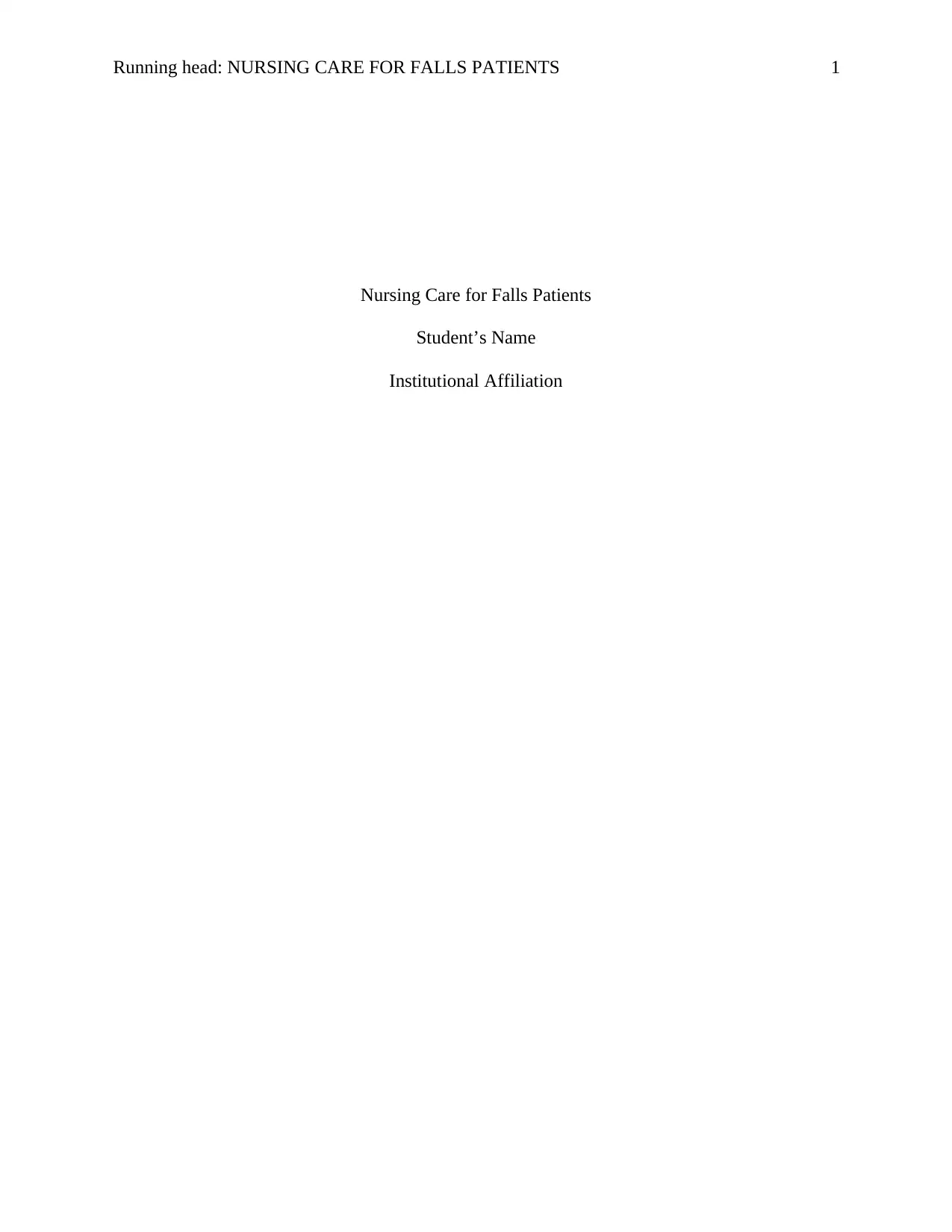
Running head: NURSING CARE FOR FALLS PATIENTS 1
Nursing Care for Falls Patients
Student’s Name
Institutional Affiliation
Nursing Care for Falls Patients
Student’s Name
Institutional Affiliation
Secure Best Marks with AI Grader
Need help grading? Try our AI Grader for instant feedback on your assignments.
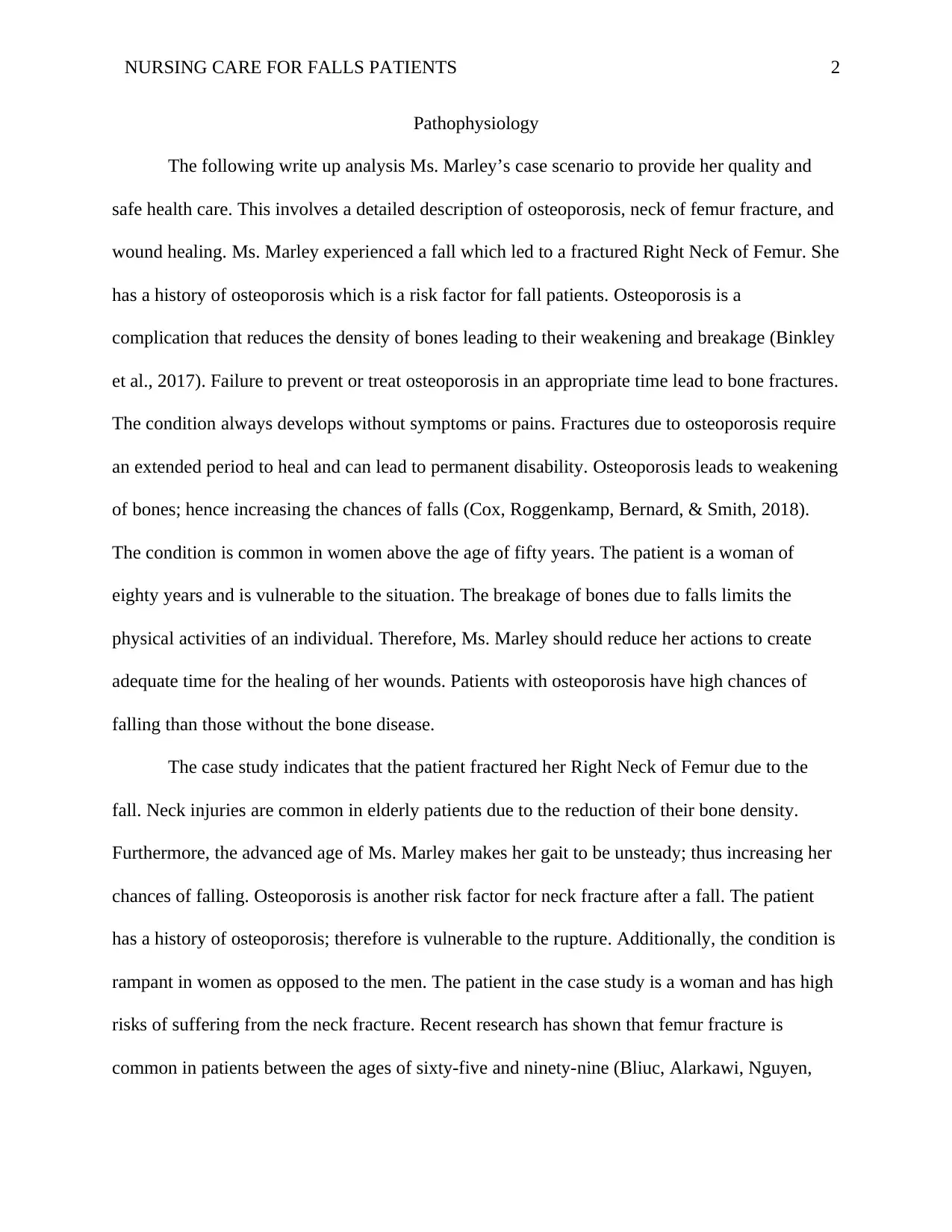
NURSING CARE FOR FALLS PATIENTS 2
Pathophysiology
The following write up analysis Ms. Marley’s case scenario to provide her quality and
safe health care. This involves a detailed description of osteoporosis, neck of femur fracture, and
wound healing. Ms. Marley experienced a fall which led to a fractured Right Neck of Femur. She
has a history of osteoporosis which is a risk factor for fall patients. Osteoporosis is a
complication that reduces the density of bones leading to their weakening and breakage (Binkley
et al., 2017). Failure to prevent or treat osteoporosis in an appropriate time lead to bone fractures.
The condition always develops without symptoms or pains. Fractures due to osteoporosis require
an extended period to heal and can lead to permanent disability. Osteoporosis leads to weakening
of bones; hence increasing the chances of falls (Cox, Roggenkamp, Bernard, & Smith, 2018).
The condition is common in women above the age of fifty years. The patient is a woman of
eighty years and is vulnerable to the situation. The breakage of bones due to falls limits the
physical activities of an individual. Therefore, Ms. Marley should reduce her actions to create
adequate time for the healing of her wounds. Patients with osteoporosis have high chances of
falling than those without the bone disease.
The case study indicates that the patient fractured her Right Neck of Femur due to the
fall. Neck injuries are common in elderly patients due to the reduction of their bone density.
Furthermore, the advanced age of Ms. Marley makes her gait to be unsteady; thus increasing her
chances of falling. Osteoporosis is another risk factor for neck fracture after a fall. The patient
has a history of osteoporosis; therefore is vulnerable to the rupture. Additionally, the condition is
rampant in women as opposed to the men. The patient in the case study is a woman and has high
risks of suffering from the neck fracture. Recent research has shown that femur fracture is
common in patients between the ages of sixty-five and ninety-nine (Bliuc, Alarkawi, Nguyen,
Pathophysiology
The following write up analysis Ms. Marley’s case scenario to provide her quality and
safe health care. This involves a detailed description of osteoporosis, neck of femur fracture, and
wound healing. Ms. Marley experienced a fall which led to a fractured Right Neck of Femur. She
has a history of osteoporosis which is a risk factor for fall patients. Osteoporosis is a
complication that reduces the density of bones leading to their weakening and breakage (Binkley
et al., 2017). Failure to prevent or treat osteoporosis in an appropriate time lead to bone fractures.
The condition always develops without symptoms or pains. Fractures due to osteoporosis require
an extended period to heal and can lead to permanent disability. Osteoporosis leads to weakening
of bones; hence increasing the chances of falls (Cox, Roggenkamp, Bernard, & Smith, 2018).
The condition is common in women above the age of fifty years. The patient is a woman of
eighty years and is vulnerable to the situation. The breakage of bones due to falls limits the
physical activities of an individual. Therefore, Ms. Marley should reduce her actions to create
adequate time for the healing of her wounds. Patients with osteoporosis have high chances of
falling than those without the bone disease.
The case study indicates that the patient fractured her Right Neck of Femur due to the
fall. Neck injuries are common in elderly patients due to the reduction of their bone density.
Furthermore, the advanced age of Ms. Marley makes her gait to be unsteady; thus increasing her
chances of falling. Osteoporosis is another risk factor for neck fracture after a fall. The patient
has a history of osteoporosis; therefore is vulnerable to the rupture. Additionally, the condition is
rampant in women as opposed to the men. The patient in the case study is a woman and has high
risks of suffering from the neck fracture. Recent research has shown that femur fracture is
common in patients between the ages of sixty-five and ninety-nine (Bliuc, Alarkawi, Nguyen,
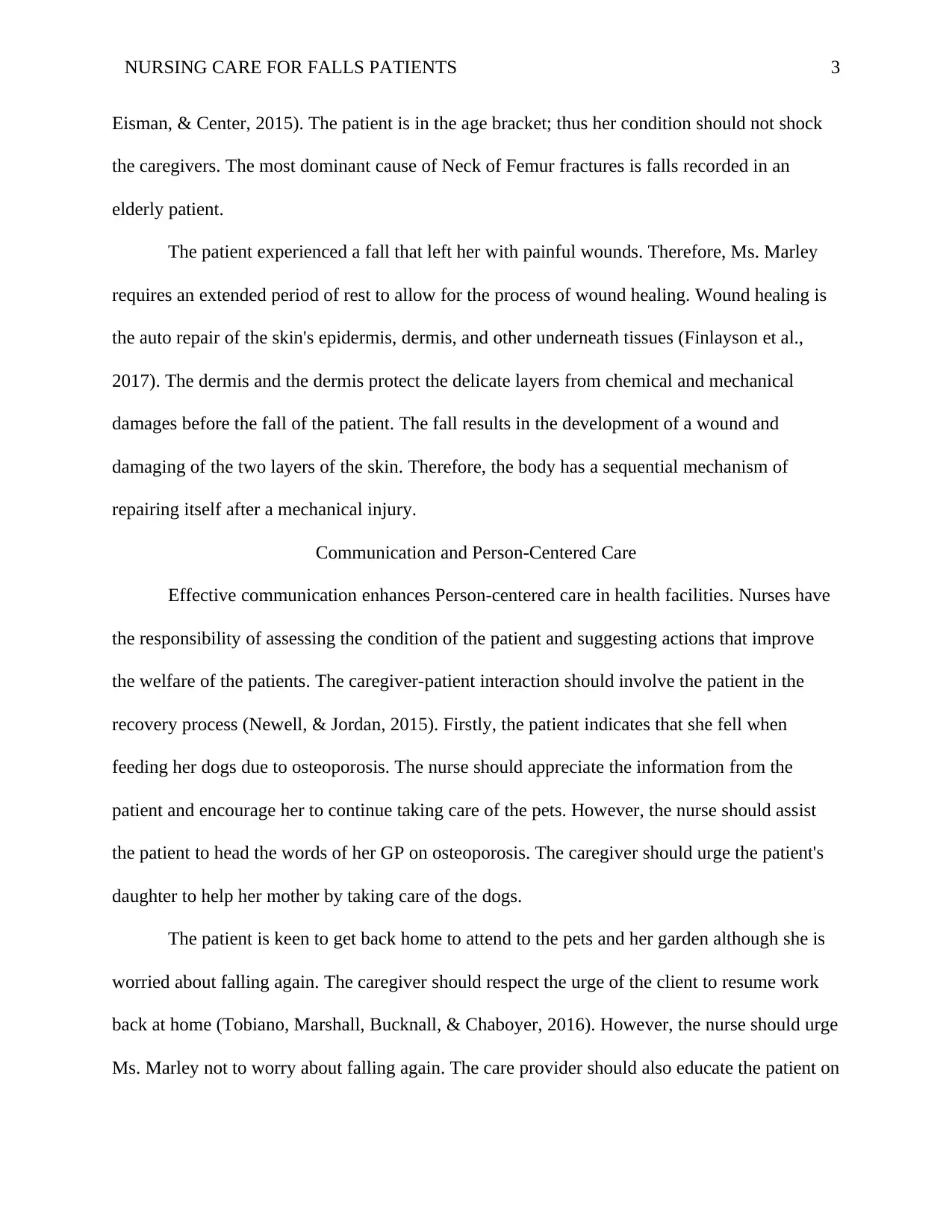
NURSING CARE FOR FALLS PATIENTS 3
Eisman, & Center, 2015). The patient is in the age bracket; thus her condition should not shock
the caregivers. The most dominant cause of Neck of Femur fractures is falls recorded in an
elderly patient.
The patient experienced a fall that left her with painful wounds. Therefore, Ms. Marley
requires an extended period of rest to allow for the process of wound healing. Wound healing is
the auto repair of the skin's epidermis, dermis, and other underneath tissues (Finlayson et al.,
2017). The dermis and the dermis protect the delicate layers from chemical and mechanical
damages before the fall of the patient. The fall results in the development of a wound and
damaging of the two layers of the skin. Therefore, the body has a sequential mechanism of
repairing itself after a mechanical injury.
Communication and Person-Centered Care
Effective communication enhances Person-centered care in health facilities. Nurses have
the responsibility of assessing the condition of the patient and suggesting actions that improve
the welfare of the patients. The caregiver-patient interaction should involve the patient in the
recovery process (Newell, & Jordan, 2015). Firstly, the patient indicates that she fell when
feeding her dogs due to osteoporosis. The nurse should appreciate the information from the
patient and encourage her to continue taking care of the pets. However, the nurse should assist
the patient to head the words of her GP on osteoporosis. The caregiver should urge the patient's
daughter to help her mother by taking care of the dogs.
The patient is keen to get back home to attend to the pets and her garden although she is
worried about falling again. The caregiver should respect the urge of the client to resume work
back at home (Tobiano, Marshall, Bucknall, & Chaboyer, 2016). However, the nurse should urge
Ms. Marley not to worry about falling again. The care provider should also educate the patient on
Eisman, & Center, 2015). The patient is in the age bracket; thus her condition should not shock
the caregivers. The most dominant cause of Neck of Femur fractures is falls recorded in an
elderly patient.
The patient experienced a fall that left her with painful wounds. Therefore, Ms. Marley
requires an extended period of rest to allow for the process of wound healing. Wound healing is
the auto repair of the skin's epidermis, dermis, and other underneath tissues (Finlayson et al.,
2017). The dermis and the dermis protect the delicate layers from chemical and mechanical
damages before the fall of the patient. The fall results in the development of a wound and
damaging of the two layers of the skin. Therefore, the body has a sequential mechanism of
repairing itself after a mechanical injury.
Communication and Person-Centered Care
Effective communication enhances Person-centered care in health facilities. Nurses have
the responsibility of assessing the condition of the patient and suggesting actions that improve
the welfare of the patients. The caregiver-patient interaction should involve the patient in the
recovery process (Newell, & Jordan, 2015). Firstly, the patient indicates that she fell when
feeding her dogs due to osteoporosis. The nurse should appreciate the information from the
patient and encourage her to continue taking care of the pets. However, the nurse should assist
the patient to head the words of her GP on osteoporosis. The caregiver should urge the patient's
daughter to help her mother by taking care of the dogs.
The patient is keen to get back home to attend to the pets and her garden although she is
worried about falling again. The caregiver should respect the urge of the client to resume work
back at home (Tobiano, Marshall, Bucknall, & Chaboyer, 2016). However, the nurse should urge
Ms. Marley not to worry about falling again. The care provider should also educate the patient on
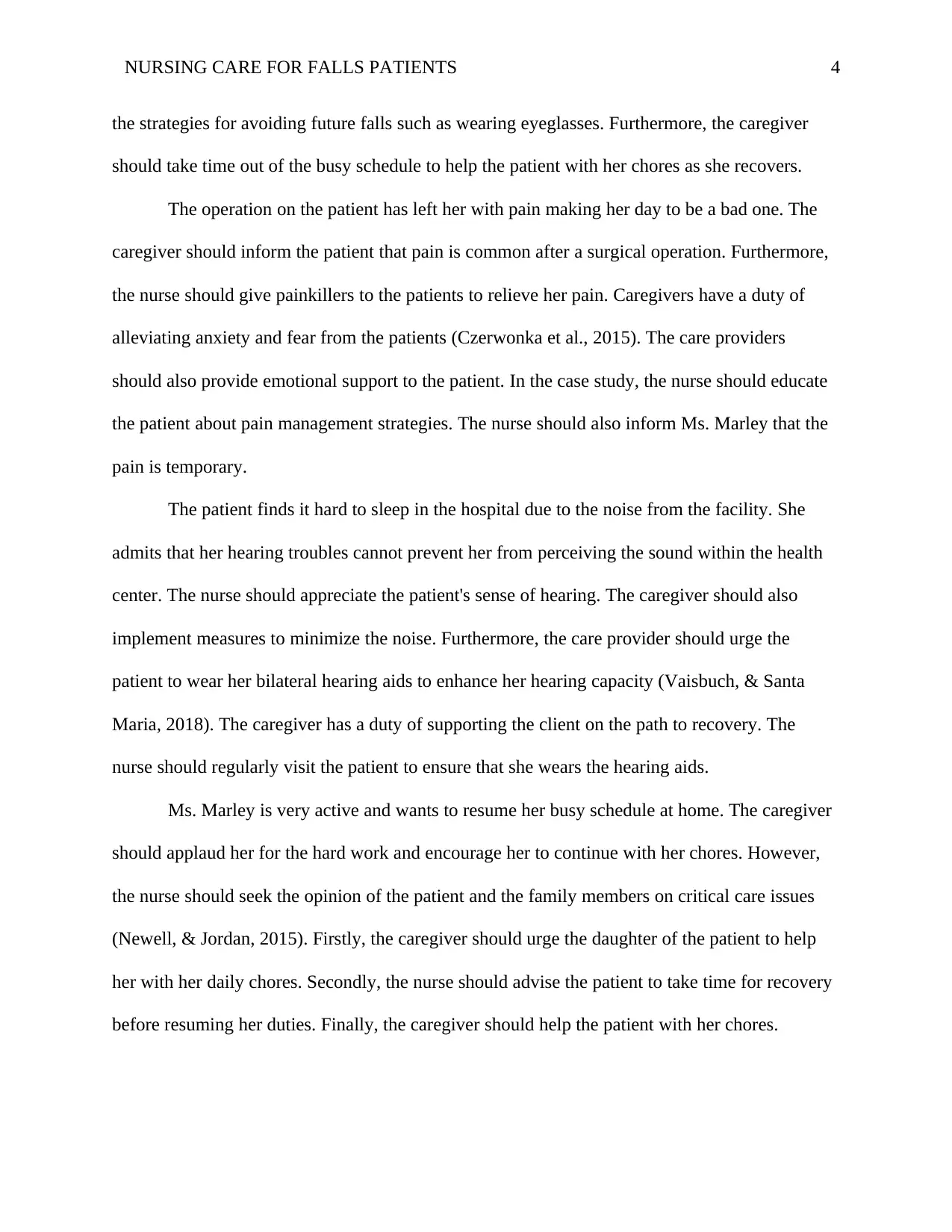
NURSING CARE FOR FALLS PATIENTS 4
the strategies for avoiding future falls such as wearing eyeglasses. Furthermore, the caregiver
should take time out of the busy schedule to help the patient with her chores as she recovers.
The operation on the patient has left her with pain making her day to be a bad one. The
caregiver should inform the patient that pain is common after a surgical operation. Furthermore,
the nurse should give painkillers to the patients to relieve her pain. Caregivers have a duty of
alleviating anxiety and fear from the patients (Czerwonka et al., 2015). The care providers
should also provide emotional support to the patient. In the case study, the nurse should educate
the patient about pain management strategies. The nurse should also inform Ms. Marley that the
pain is temporary.
The patient finds it hard to sleep in the hospital due to the noise from the facility. She
admits that her hearing troubles cannot prevent her from perceiving the sound within the health
center. The nurse should appreciate the patient's sense of hearing. The caregiver should also
implement measures to minimize the noise. Furthermore, the care provider should urge the
patient to wear her bilateral hearing aids to enhance her hearing capacity (Vaisbuch, & Santa
Maria, 2018). The caregiver has a duty of supporting the client on the path to recovery. The
nurse should regularly visit the patient to ensure that she wears the hearing aids.
Ms. Marley is very active and wants to resume her busy schedule at home. The caregiver
should applaud her for the hard work and encourage her to continue with her chores. However,
the nurse should seek the opinion of the patient and the family members on critical care issues
(Newell, & Jordan, 2015). Firstly, the caregiver should urge the daughter of the patient to help
her with her daily chores. Secondly, the nurse should advise the patient to take time for recovery
before resuming her duties. Finally, the caregiver should help the patient with her chores.
the strategies for avoiding future falls such as wearing eyeglasses. Furthermore, the caregiver
should take time out of the busy schedule to help the patient with her chores as she recovers.
The operation on the patient has left her with pain making her day to be a bad one. The
caregiver should inform the patient that pain is common after a surgical operation. Furthermore,
the nurse should give painkillers to the patients to relieve her pain. Caregivers have a duty of
alleviating anxiety and fear from the patients (Czerwonka et al., 2015). The care providers
should also provide emotional support to the patient. In the case study, the nurse should educate
the patient about pain management strategies. The nurse should also inform Ms. Marley that the
pain is temporary.
The patient finds it hard to sleep in the hospital due to the noise from the facility. She
admits that her hearing troubles cannot prevent her from perceiving the sound within the health
center. The nurse should appreciate the patient's sense of hearing. The caregiver should also
implement measures to minimize the noise. Furthermore, the care provider should urge the
patient to wear her bilateral hearing aids to enhance her hearing capacity (Vaisbuch, & Santa
Maria, 2018). The caregiver has a duty of supporting the client on the path to recovery. The
nurse should regularly visit the patient to ensure that she wears the hearing aids.
Ms. Marley is very active and wants to resume her busy schedule at home. The caregiver
should applaud her for the hard work and encourage her to continue with her chores. However,
the nurse should seek the opinion of the patient and the family members on critical care issues
(Newell, & Jordan, 2015). Firstly, the caregiver should urge the daughter of the patient to help
her with her daily chores. Secondly, the nurse should advise the patient to take time for recovery
before resuming her duties. Finally, the caregiver should help the patient with her chores.
Secure Best Marks with AI Grader
Need help grading? Try our AI Grader for instant feedback on your assignments.
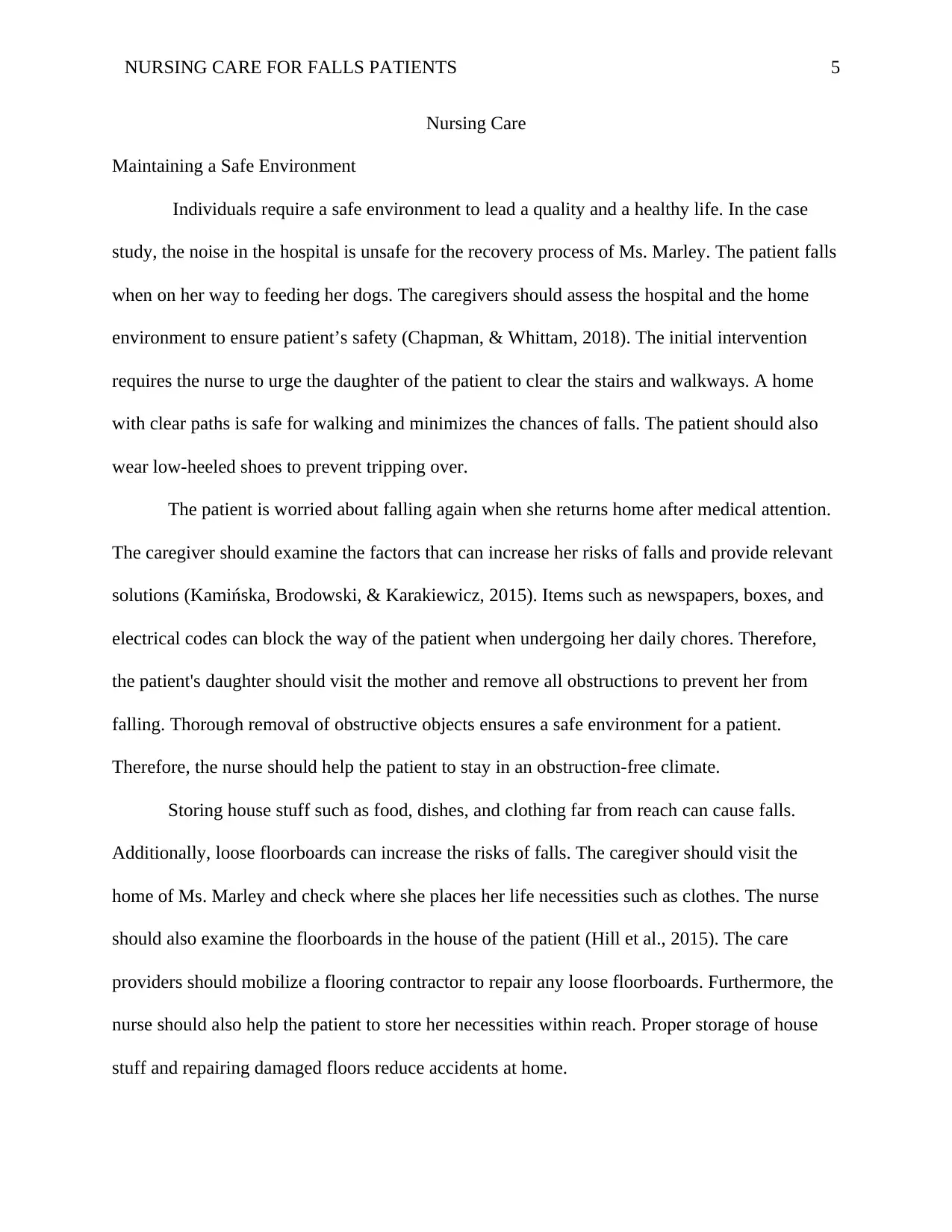
NURSING CARE FOR FALLS PATIENTS 5
Nursing Care
Maintaining a Safe Environment
Individuals require a safe environment to lead a quality and a healthy life. In the case
study, the noise in the hospital is unsafe for the recovery process of Ms. Marley. The patient falls
when on her way to feeding her dogs. The caregivers should assess the hospital and the home
environment to ensure patient’s safety (Chapman, & Whittam, 2018). The initial intervention
requires the nurse to urge the daughter of the patient to clear the stairs and walkways. A home
with clear paths is safe for walking and minimizes the chances of falls. The patient should also
wear low-heeled shoes to prevent tripping over.
The patient is worried about falling again when she returns home after medical attention.
The caregiver should examine the factors that can increase her risks of falls and provide relevant
solutions (Kamińska, Brodowski, & Karakiewicz, 2015). Items such as newspapers, boxes, and
electrical codes can block the way of the patient when undergoing her daily chores. Therefore,
the patient's daughter should visit the mother and remove all obstructions to prevent her from
falling. Thorough removal of obstructive objects ensures a safe environment for a patient.
Therefore, the nurse should help the patient to stay in an obstruction-free climate.
Storing house stuff such as food, dishes, and clothing far from reach can cause falls.
Additionally, loose floorboards can increase the risks of falls. The caregiver should visit the
home of Ms. Marley and check where she places her life necessities such as clothes. The nurse
should also examine the floorboards in the house of the patient (Hill et al., 2015). The care
providers should mobilize a flooring contractor to repair any loose floorboards. Furthermore, the
nurse should also help the patient to store her necessities within reach. Proper storage of house
stuff and repairing damaged floors reduce accidents at home.
Nursing Care
Maintaining a Safe Environment
Individuals require a safe environment to lead a quality and a healthy life. In the case
study, the noise in the hospital is unsafe for the recovery process of Ms. Marley. The patient falls
when on her way to feeding her dogs. The caregivers should assess the hospital and the home
environment to ensure patient’s safety (Chapman, & Whittam, 2018). The initial intervention
requires the nurse to urge the daughter of the patient to clear the stairs and walkways. A home
with clear paths is safe for walking and minimizes the chances of falls. The patient should also
wear low-heeled shoes to prevent tripping over.
The patient is worried about falling again when she returns home after medical attention.
The caregiver should examine the factors that can increase her risks of falls and provide relevant
solutions (Kamińska, Brodowski, & Karakiewicz, 2015). Items such as newspapers, boxes, and
electrical codes can block the way of the patient when undergoing her daily chores. Therefore,
the patient's daughter should visit the mother and remove all obstructions to prevent her from
falling. Thorough removal of obstructive objects ensures a safe environment for a patient.
Therefore, the nurse should help the patient to stay in an obstruction-free climate.
Storing house stuff such as food, dishes, and clothing far from reach can cause falls.
Additionally, loose floorboards can increase the risks of falls. The caregiver should visit the
home of Ms. Marley and check where she places her life necessities such as clothes. The nurse
should also examine the floorboards in the house of the patient (Hill et al., 2015). The care
providers should mobilize a flooring contractor to repair any loose floorboards. Furthermore, the
nurse should also help the patient to store her necessities within reach. Proper storage of house
stuff and repairing damaged floors reduce accidents at home.
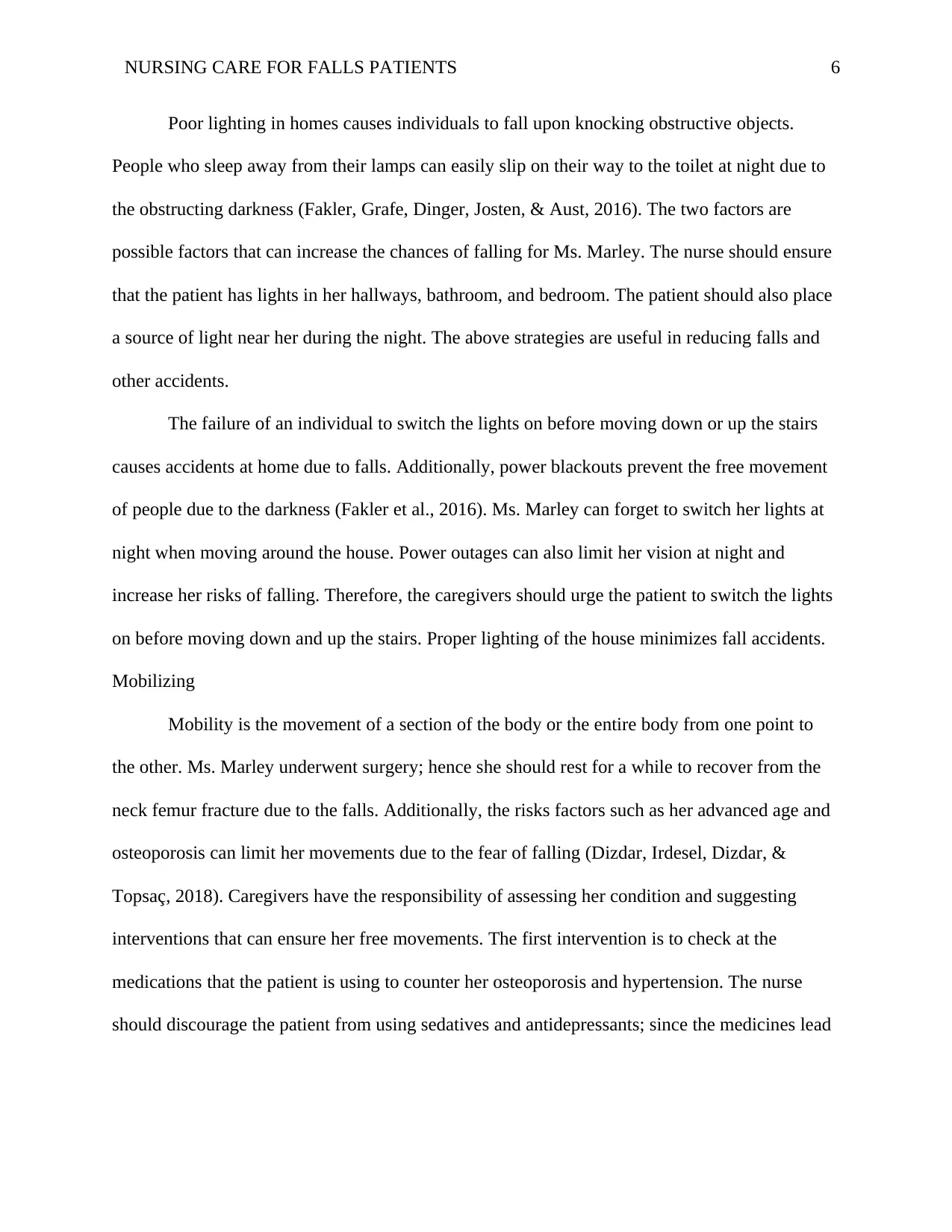
NURSING CARE FOR FALLS PATIENTS 6
Poor lighting in homes causes individuals to fall upon knocking obstructive objects.
People who sleep away from their lamps can easily slip on their way to the toilet at night due to
the obstructing darkness (Fakler, Grafe, Dinger, Josten, & Aust, 2016). The two factors are
possible factors that can increase the chances of falling for Ms. Marley. The nurse should ensure
that the patient has lights in her hallways, bathroom, and bedroom. The patient should also place
a source of light near her during the night. The above strategies are useful in reducing falls and
other accidents.
The failure of an individual to switch the lights on before moving down or up the stairs
causes accidents at home due to falls. Additionally, power blackouts prevent the free movement
of people due to the darkness (Fakler et al., 2016). Ms. Marley can forget to switch her lights at
night when moving around the house. Power outages can also limit her vision at night and
increase her risks of falling. Therefore, the caregivers should urge the patient to switch the lights
on before moving down and up the stairs. Proper lighting of the house minimizes fall accidents.
Mobilizing
Mobility is the movement of a section of the body or the entire body from one point to
the other. Ms. Marley underwent surgery; hence she should rest for a while to recover from the
neck femur fracture due to the falls. Additionally, the risks factors such as her advanced age and
osteoporosis can limit her movements due to the fear of falling (Dizdar, Irdesel, Dizdar, &
Topsaç, 2018). Caregivers have the responsibility of assessing her condition and suggesting
interventions that can ensure her free movements. The first intervention is to check at the
medications that the patient is using to counter her osteoporosis and hypertension. The nurse
should discourage the patient from using sedatives and antidepressants; since the medicines lead
Poor lighting in homes causes individuals to fall upon knocking obstructive objects.
People who sleep away from their lamps can easily slip on their way to the toilet at night due to
the obstructing darkness (Fakler, Grafe, Dinger, Josten, & Aust, 2016). The two factors are
possible factors that can increase the chances of falling for Ms. Marley. The nurse should ensure
that the patient has lights in her hallways, bathroom, and bedroom. The patient should also place
a source of light near her during the night. The above strategies are useful in reducing falls and
other accidents.
The failure of an individual to switch the lights on before moving down or up the stairs
causes accidents at home due to falls. Additionally, power blackouts prevent the free movement
of people due to the darkness (Fakler et al., 2016). Ms. Marley can forget to switch her lights at
night when moving around the house. Power outages can also limit her vision at night and
increase her risks of falling. Therefore, the caregivers should urge the patient to switch the lights
on before moving down and up the stairs. Proper lighting of the house minimizes fall accidents.
Mobilizing
Mobility is the movement of a section of the body or the entire body from one point to
the other. Ms. Marley underwent surgery; hence she should rest for a while to recover from the
neck femur fracture due to the falls. Additionally, the risks factors such as her advanced age and
osteoporosis can limit her movements due to the fear of falling (Dizdar, Irdesel, Dizdar, &
Topsaç, 2018). Caregivers have the responsibility of assessing her condition and suggesting
interventions that can ensure her free movements. The first intervention is to check at the
medications that the patient is using to counter her osteoporosis and hypertension. The nurse
should discourage the patient from using sedatives and antidepressants; since the medicines lead
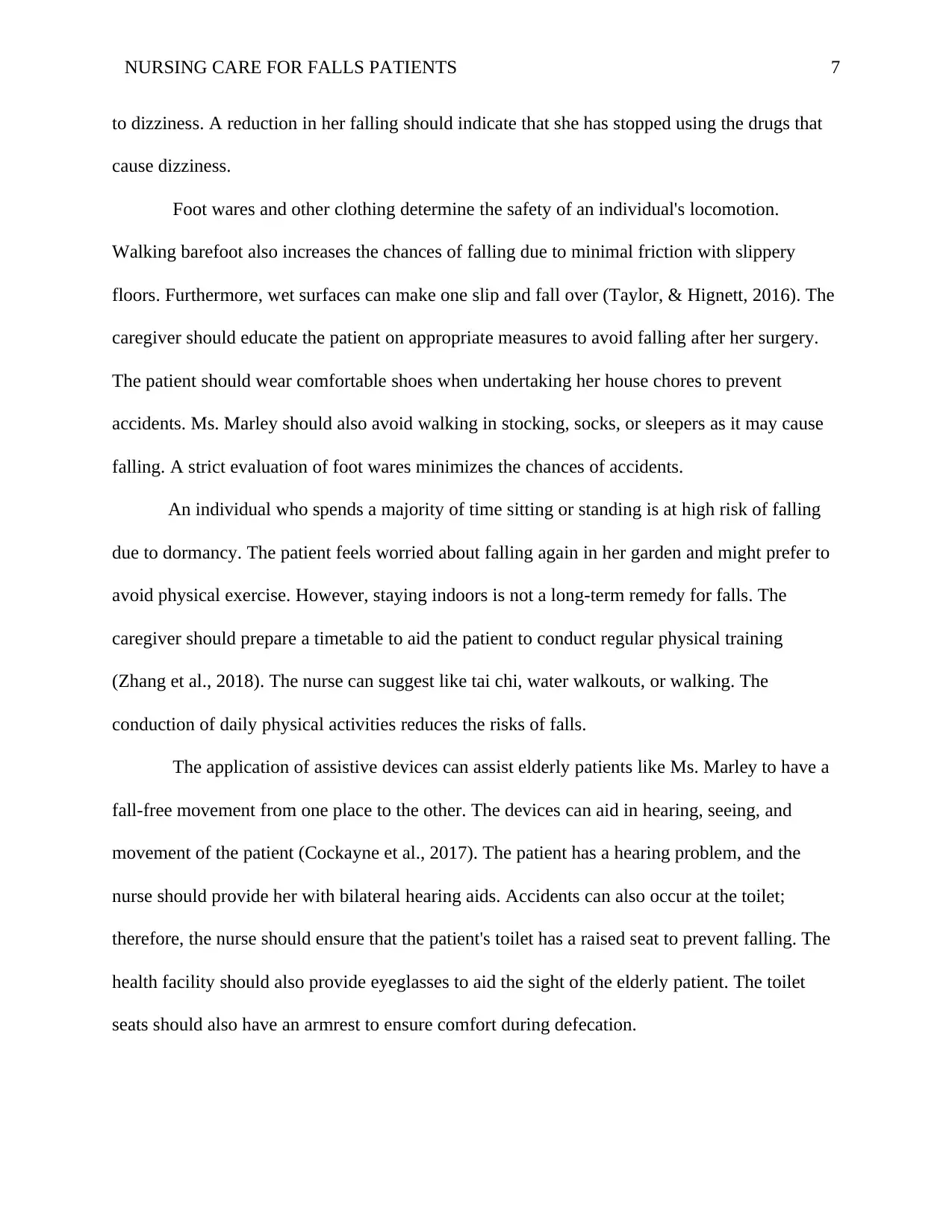
NURSING CARE FOR FALLS PATIENTS 7
to dizziness. A reduction in her falling should indicate that she has stopped using the drugs that
cause dizziness.
Foot wares and other clothing determine the safety of an individual's locomotion.
Walking barefoot also increases the chances of falling due to minimal friction with slippery
floors. Furthermore, wet surfaces can make one slip and fall over (Taylor, & Hignett, 2016). The
caregiver should educate the patient on appropriate measures to avoid falling after her surgery.
The patient should wear comfortable shoes when undertaking her house chores to prevent
accidents. Ms. Marley should also avoid walking in stocking, socks, or sleepers as it may cause
falling. A strict evaluation of foot wares minimizes the chances of accidents.
An individual who spends a majority of time sitting or standing is at high risk of falling
due to dormancy. The patient feels worried about falling again in her garden and might prefer to
avoid physical exercise. However, staying indoors is not a long-term remedy for falls. The
caregiver should prepare a timetable to aid the patient to conduct regular physical training
(Zhang et al., 2018). The nurse can suggest like tai chi, water walkouts, or walking. The
conduction of daily physical activities reduces the risks of falls.
The application of assistive devices can assist elderly patients like Ms. Marley to have a
fall-free movement from one place to the other. The devices can aid in hearing, seeing, and
movement of the patient (Cockayne et al., 2017). The patient has a hearing problem, and the
nurse should provide her with bilateral hearing aids. Accidents can also occur at the toilet;
therefore, the nurse should ensure that the patient's toilet has a raised seat to prevent falling. The
health facility should also provide eyeglasses to aid the sight of the elderly patient. The toilet
seats should also have an armrest to ensure comfort during defecation.
to dizziness. A reduction in her falling should indicate that she has stopped using the drugs that
cause dizziness.
Foot wares and other clothing determine the safety of an individual's locomotion.
Walking barefoot also increases the chances of falling due to minimal friction with slippery
floors. Furthermore, wet surfaces can make one slip and fall over (Taylor, & Hignett, 2016). The
caregiver should educate the patient on appropriate measures to avoid falling after her surgery.
The patient should wear comfortable shoes when undertaking her house chores to prevent
accidents. Ms. Marley should also avoid walking in stocking, socks, or sleepers as it may cause
falling. A strict evaluation of foot wares minimizes the chances of accidents.
An individual who spends a majority of time sitting or standing is at high risk of falling
due to dormancy. The patient feels worried about falling again in her garden and might prefer to
avoid physical exercise. However, staying indoors is not a long-term remedy for falls. The
caregiver should prepare a timetable to aid the patient to conduct regular physical training
(Zhang et al., 2018). The nurse can suggest like tai chi, water walkouts, or walking. The
conduction of daily physical activities reduces the risks of falls.
The application of assistive devices can assist elderly patients like Ms. Marley to have a
fall-free movement from one place to the other. The devices can aid in hearing, seeing, and
movement of the patient (Cockayne et al., 2017). The patient has a hearing problem, and the
nurse should provide her with bilateral hearing aids. Accidents can also occur at the toilet;
therefore, the nurse should ensure that the patient's toilet has a raised seat to prevent falling. The
health facility should also provide eyeglasses to aid the sight of the elderly patient. The toilet
seats should also have an armrest to ensure comfort during defecation.
Paraphrase This Document
Need a fresh take? Get an instant paraphrase of this document with our AI Paraphraser
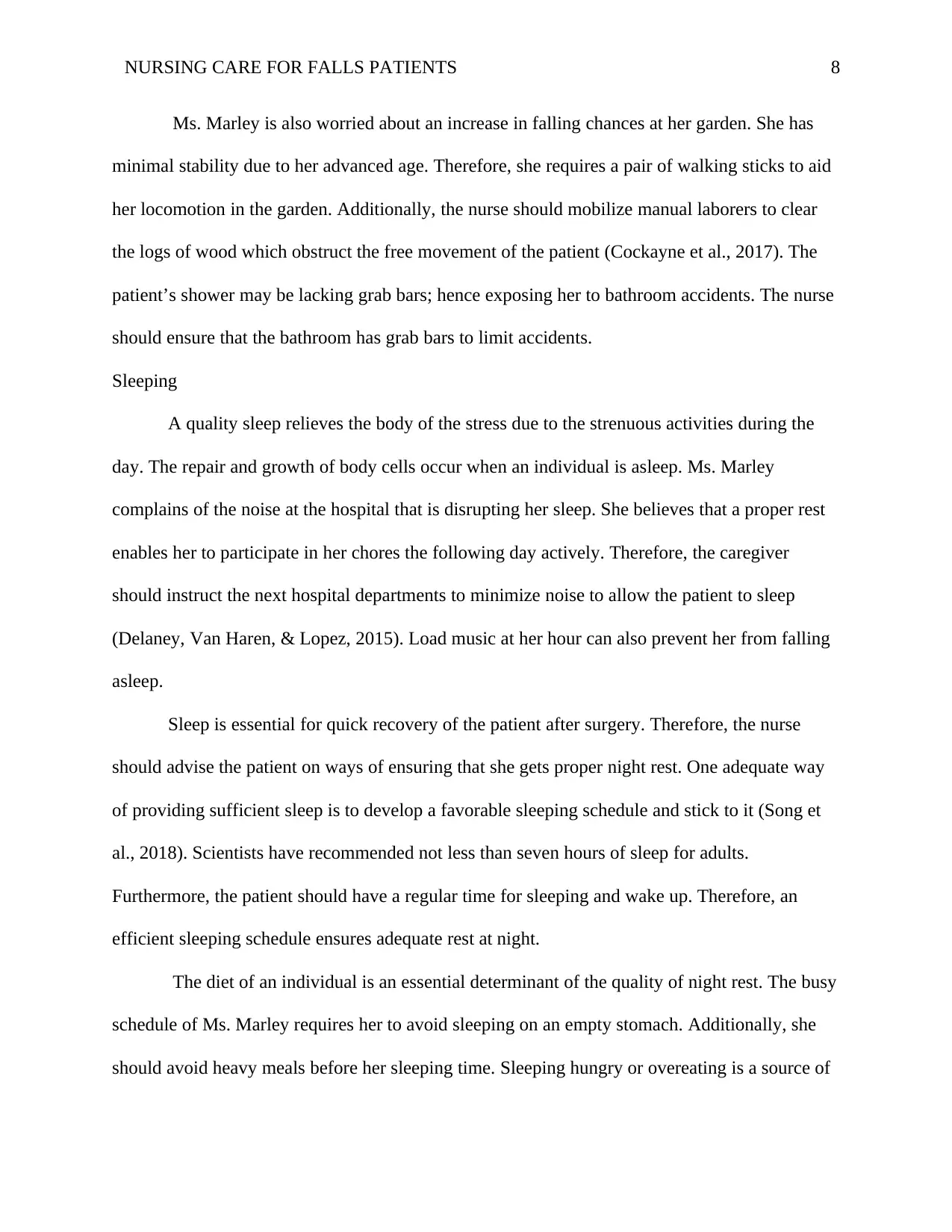
NURSING CARE FOR FALLS PATIENTS 8
Ms. Marley is also worried about an increase in falling chances at her garden. She has
minimal stability due to her advanced age. Therefore, she requires a pair of walking sticks to aid
her locomotion in the garden. Additionally, the nurse should mobilize manual laborers to clear
the logs of wood which obstruct the free movement of the patient (Cockayne et al., 2017). The
patient’s shower may be lacking grab bars; hence exposing her to bathroom accidents. The nurse
should ensure that the bathroom has grab bars to limit accidents.
Sleeping
A quality sleep relieves the body of the stress due to the strenuous activities during the
day. The repair and growth of body cells occur when an individual is asleep. Ms. Marley
complains of the noise at the hospital that is disrupting her sleep. She believes that a proper rest
enables her to participate in her chores the following day actively. Therefore, the caregiver
should instruct the next hospital departments to minimize noise to allow the patient to sleep
(Delaney, Van Haren, & Lopez, 2015). Load music at her hour can also prevent her from falling
asleep.
Sleep is essential for quick recovery of the patient after surgery. Therefore, the nurse
should advise the patient on ways of ensuring that she gets proper night rest. One adequate way
of providing sufficient sleep is to develop a favorable sleeping schedule and stick to it (Song et
al., 2018). Scientists have recommended not less than seven hours of sleep for adults.
Furthermore, the patient should have a regular time for sleeping and wake up. Therefore, an
efficient sleeping schedule ensures adequate rest at night.
The diet of an individual is an essential determinant of the quality of night rest. The busy
schedule of Ms. Marley requires her to avoid sleeping on an empty stomach. Additionally, she
should avoid heavy meals before her sleeping time. Sleeping hungry or overeating is a source of
Ms. Marley is also worried about an increase in falling chances at her garden. She has
minimal stability due to her advanced age. Therefore, she requires a pair of walking sticks to aid
her locomotion in the garden. Additionally, the nurse should mobilize manual laborers to clear
the logs of wood which obstruct the free movement of the patient (Cockayne et al., 2017). The
patient’s shower may be lacking grab bars; hence exposing her to bathroom accidents. The nurse
should ensure that the bathroom has grab bars to limit accidents.
Sleeping
A quality sleep relieves the body of the stress due to the strenuous activities during the
day. The repair and growth of body cells occur when an individual is asleep. Ms. Marley
complains of the noise at the hospital that is disrupting her sleep. She believes that a proper rest
enables her to participate in her chores the following day actively. Therefore, the caregiver
should instruct the next hospital departments to minimize noise to allow the patient to sleep
(Delaney, Van Haren, & Lopez, 2015). Load music at her hour can also prevent her from falling
asleep.
Sleep is essential for quick recovery of the patient after surgery. Therefore, the nurse
should advise the patient on ways of ensuring that she gets proper night rest. One adequate way
of providing sufficient sleep is to develop a favorable sleeping schedule and stick to it (Song et
al., 2018). Scientists have recommended not less than seven hours of sleep for adults.
Furthermore, the patient should have a regular time for sleeping and wake up. Therefore, an
efficient sleeping schedule ensures adequate rest at night.
The diet of an individual is an essential determinant of the quality of night rest. The busy
schedule of Ms. Marley requires her to avoid sleeping on an empty stomach. Additionally, she
should avoid heavy meals before her sleeping time. Sleeping hungry or overeating is a source of
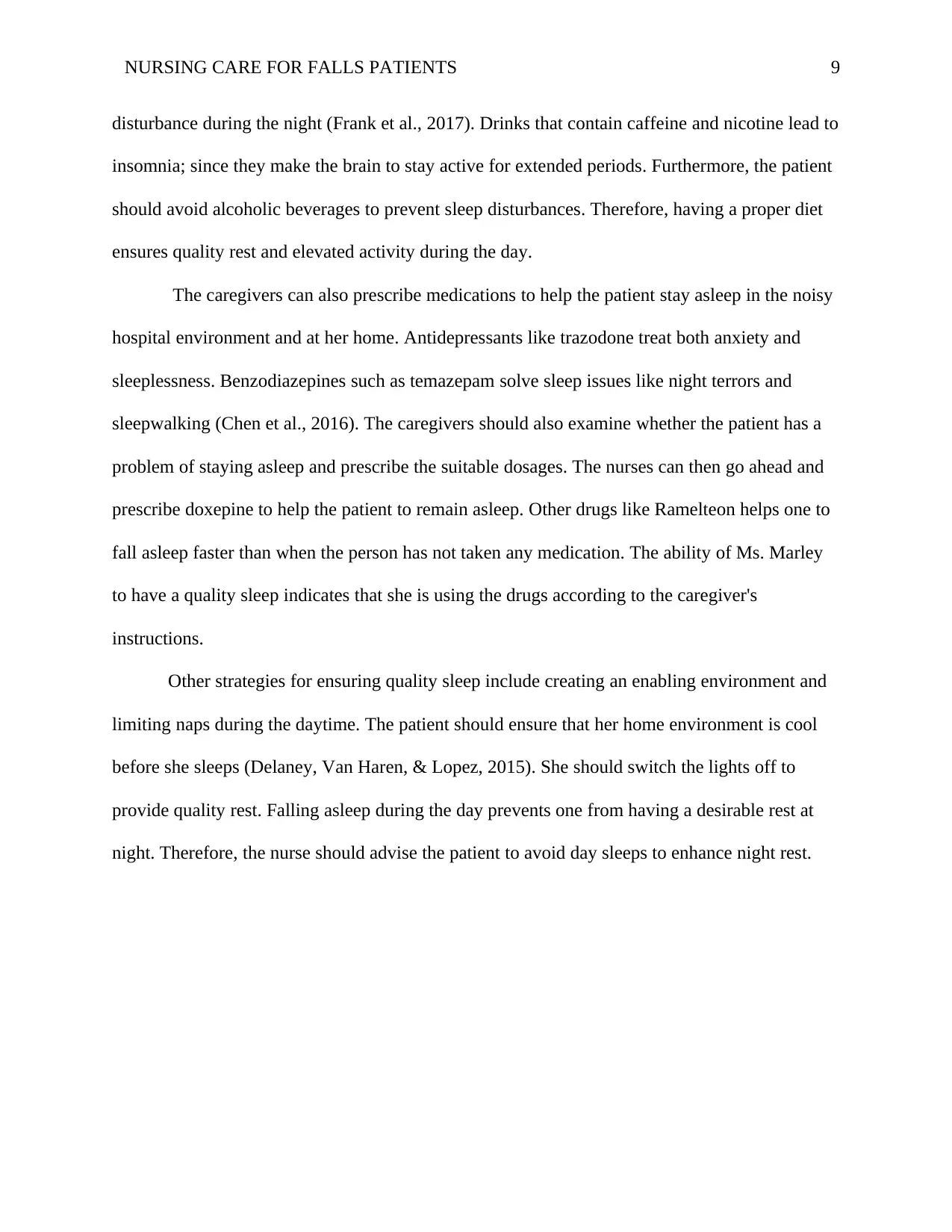
NURSING CARE FOR FALLS PATIENTS 9
disturbance during the night (Frank et al., 2017). Drinks that contain caffeine and nicotine lead to
insomnia; since they make the brain to stay active for extended periods. Furthermore, the patient
should avoid alcoholic beverages to prevent sleep disturbances. Therefore, having a proper diet
ensures quality rest and elevated activity during the day.
The caregivers can also prescribe medications to help the patient stay asleep in the noisy
hospital environment and at her home. Antidepressants like trazodone treat both anxiety and
sleeplessness. Benzodiazepines such as temazepam solve sleep issues like night terrors and
sleepwalking (Chen et al., 2016). The caregivers should also examine whether the patient has a
problem of staying asleep and prescribe the suitable dosages. The nurses can then go ahead and
prescribe doxepine to help the patient to remain asleep. Other drugs like Ramelteon helps one to
fall asleep faster than when the person has not taken any medication. The ability of Ms. Marley
to have a quality sleep indicates that she is using the drugs according to the caregiver's
instructions.
Other strategies for ensuring quality sleep include creating an enabling environment and
limiting naps during the daytime. The patient should ensure that her home environment is cool
before she sleeps (Delaney, Van Haren, & Lopez, 2015). She should switch the lights off to
provide quality rest. Falling asleep during the day prevents one from having a desirable rest at
night. Therefore, the nurse should advise the patient to avoid day sleeps to enhance night rest.
disturbance during the night (Frank et al., 2017). Drinks that contain caffeine and nicotine lead to
insomnia; since they make the brain to stay active for extended periods. Furthermore, the patient
should avoid alcoholic beverages to prevent sleep disturbances. Therefore, having a proper diet
ensures quality rest and elevated activity during the day.
The caregivers can also prescribe medications to help the patient stay asleep in the noisy
hospital environment and at her home. Antidepressants like trazodone treat both anxiety and
sleeplessness. Benzodiazepines such as temazepam solve sleep issues like night terrors and
sleepwalking (Chen et al., 2016). The caregivers should also examine whether the patient has a
problem of staying asleep and prescribe the suitable dosages. The nurses can then go ahead and
prescribe doxepine to help the patient to remain asleep. Other drugs like Ramelteon helps one to
fall asleep faster than when the person has not taken any medication. The ability of Ms. Marley
to have a quality sleep indicates that she is using the drugs according to the caregiver's
instructions.
Other strategies for ensuring quality sleep include creating an enabling environment and
limiting naps during the daytime. The patient should ensure that her home environment is cool
before she sleeps (Delaney, Van Haren, & Lopez, 2015). She should switch the lights off to
provide quality rest. Falling asleep during the day prevents one from having a desirable rest at
night. Therefore, the nurse should advise the patient to avoid day sleeps to enhance night rest.
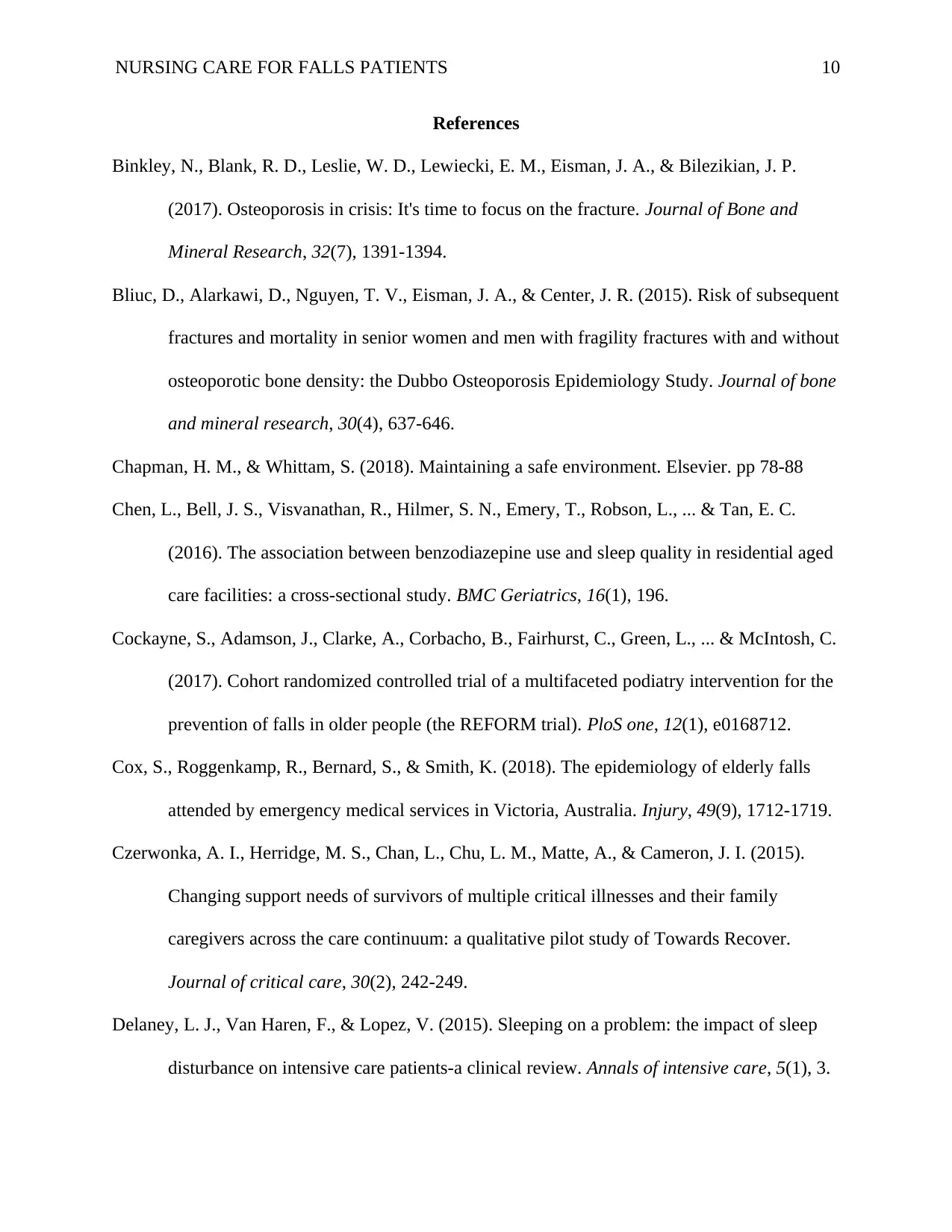
NURSING CARE FOR FALLS PATIENTS 10
References
Binkley, N., Blank, R. D., Leslie, W. D., Lewiecki, E. M., Eisman, J. A., & Bilezikian, J. P.
(2017). Osteoporosis in crisis: It's time to focus on the fracture. Journal of Bone and
Mineral Research, 32(7), 1391-1394.
Bliuc, D., Alarkawi, D., Nguyen, T. V., Eisman, J. A., & Center, J. R. (2015). Risk of subsequent
fractures and mortality in senior women and men with fragility fractures with and without
osteoporotic bone density: the Dubbo Osteoporosis Epidemiology Study. Journal of bone
and mineral research, 30(4), 637-646.
Chapman, H. M., & Whittam, S. (2018). Maintaining a safe environment. Elsevier. pp 78-88
Chen, L., Bell, J. S., Visvanathan, R., Hilmer, S. N., Emery, T., Robson, L., ... & Tan, E. C.
(2016). The association between benzodiazepine use and sleep quality in residential aged
care facilities: a cross-sectional study. BMC Geriatrics, 16(1), 196.
Cockayne, S., Adamson, J., Clarke, A., Corbacho, B., Fairhurst, C., Green, L., ... & McIntosh, C.
(2017). Cohort randomized controlled trial of a multifaceted podiatry intervention for the
prevention of falls in older people (the REFORM trial). PloS one, 12(1), e0168712.
Cox, S., Roggenkamp, R., Bernard, S., & Smith, K. (2018). The epidemiology of elderly falls
attended by emergency medical services in Victoria, Australia. Injury, 49(9), 1712-1719.
Czerwonka, A. I., Herridge, M. S., Chan, L., Chu, L. M., Matte, A., & Cameron, J. I. (2015).
Changing support needs of survivors of multiple critical illnesses and their family
caregivers across the care continuum: a qualitative pilot study of Towards Recover.
Journal of critical care, 30(2), 242-249.
Delaney, L. J., Van Haren, F., & Lopez, V. (2015). Sleeping on a problem: the impact of sleep
disturbance on intensive care patients-a clinical review. Annals of intensive care, 5(1), 3.
References
Binkley, N., Blank, R. D., Leslie, W. D., Lewiecki, E. M., Eisman, J. A., & Bilezikian, J. P.
(2017). Osteoporosis in crisis: It's time to focus on the fracture. Journal of Bone and
Mineral Research, 32(7), 1391-1394.
Bliuc, D., Alarkawi, D., Nguyen, T. V., Eisman, J. A., & Center, J. R. (2015). Risk of subsequent
fractures and mortality in senior women and men with fragility fractures with and without
osteoporotic bone density: the Dubbo Osteoporosis Epidemiology Study. Journal of bone
and mineral research, 30(4), 637-646.
Chapman, H. M., & Whittam, S. (2018). Maintaining a safe environment. Elsevier. pp 78-88
Chen, L., Bell, J. S., Visvanathan, R., Hilmer, S. N., Emery, T., Robson, L., ... & Tan, E. C.
(2016). The association between benzodiazepine use and sleep quality in residential aged
care facilities: a cross-sectional study. BMC Geriatrics, 16(1), 196.
Cockayne, S., Adamson, J., Clarke, A., Corbacho, B., Fairhurst, C., Green, L., ... & McIntosh, C.
(2017). Cohort randomized controlled trial of a multifaceted podiatry intervention for the
prevention of falls in older people (the REFORM trial). PloS one, 12(1), e0168712.
Cox, S., Roggenkamp, R., Bernard, S., & Smith, K. (2018). The epidemiology of elderly falls
attended by emergency medical services in Victoria, Australia. Injury, 49(9), 1712-1719.
Czerwonka, A. I., Herridge, M. S., Chan, L., Chu, L. M., Matte, A., & Cameron, J. I. (2015).
Changing support needs of survivors of multiple critical illnesses and their family
caregivers across the care continuum: a qualitative pilot study of Towards Recover.
Journal of critical care, 30(2), 242-249.
Delaney, L. J., Van Haren, F., & Lopez, V. (2015). Sleeping on a problem: the impact of sleep
disturbance on intensive care patients-a clinical review. Annals of intensive care, 5(1), 3.
Secure Best Marks with AI Grader
Need help grading? Try our AI Grader for instant feedback on your assignments.
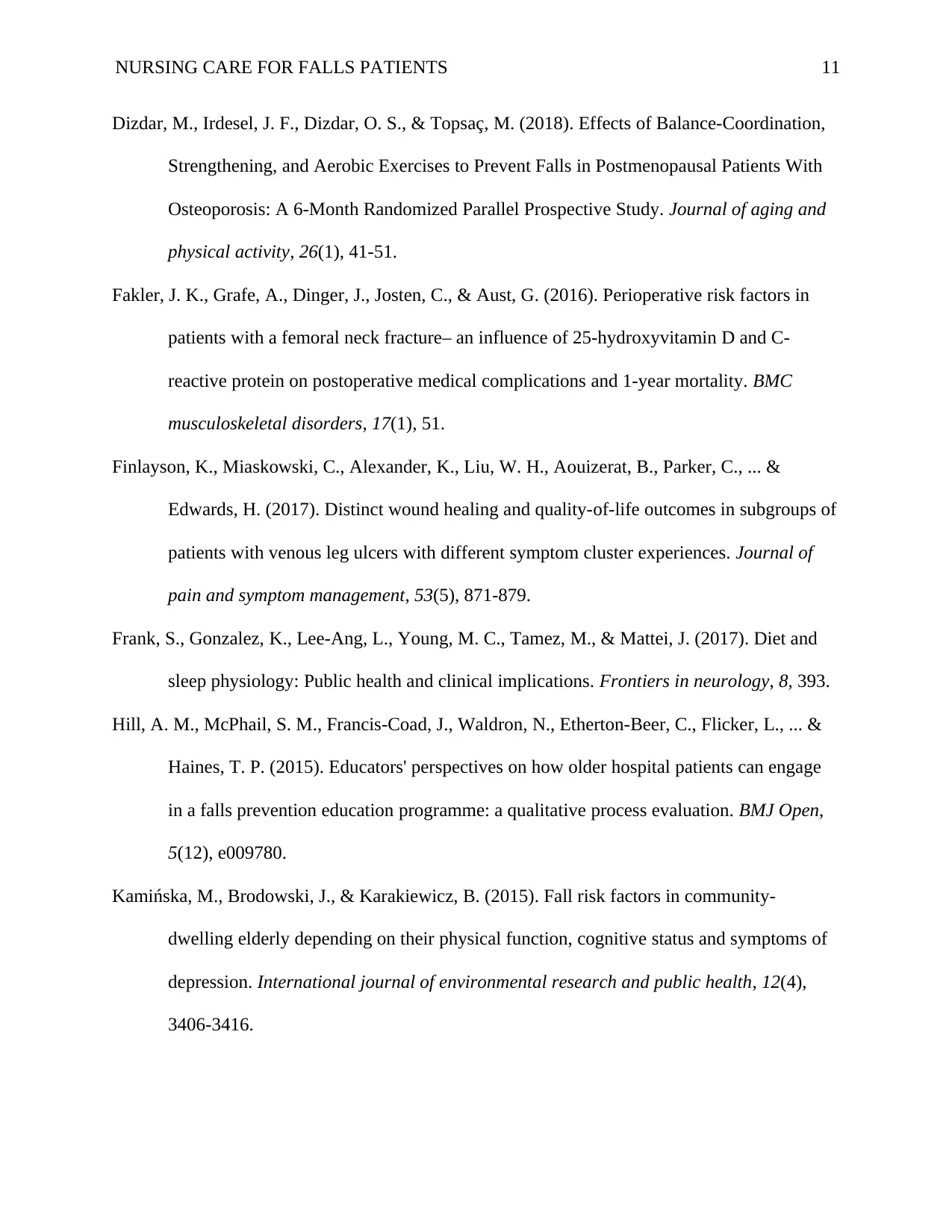
NURSING CARE FOR FALLS PATIENTS 11
Dizdar, M., Irdesel, J. F., Dizdar, O. S., & Topsaç, M. (2018). Effects of Balance-Coordination,
Strengthening, and Aerobic Exercises to Prevent Falls in Postmenopausal Patients With
Osteoporosis: A 6-Month Randomized Parallel Prospective Study. Journal of aging and
physical activity, 26(1), 41-51.
Fakler, J. K., Grafe, A., Dinger, J., Josten, C., & Aust, G. (2016). Perioperative risk factors in
patients with a femoral neck fracture– an influence of 25-hydroxyvitamin D and C-
reactive protein on postoperative medical complications and 1-year mortality. BMC
musculoskeletal disorders, 17(1), 51.
Finlayson, K., Miaskowski, C., Alexander, K., Liu, W. H., Aouizerat, B., Parker, C., ... &
Edwards, H. (2017). Distinct wound healing and quality-of-life outcomes in subgroups of
patients with venous leg ulcers with different symptom cluster experiences. Journal of
pain and symptom management, 53(5), 871-879.
Frank, S., Gonzalez, K., Lee-Ang, L., Young, M. C., Tamez, M., & Mattei, J. (2017). Diet and
sleep physiology: Public health and clinical implications. Frontiers in neurology, 8, 393.
Hill, A. M., McPhail, S. M., Francis-Coad, J., Waldron, N., Etherton-Beer, C., Flicker, L., ... &
Haines, T. P. (2015). Educators' perspectives on how older hospital patients can engage
in a falls prevention education programme: a qualitative process evaluation. BMJ Open,
5(12), e009780.
Kamińska, M., Brodowski, J., & Karakiewicz, B. (2015). Fall risk factors in community-
dwelling elderly depending on their physical function, cognitive status and symptoms of
depression. International journal of environmental research and public health, 12(4),
3406-3416.
Dizdar, M., Irdesel, J. F., Dizdar, O. S., & Topsaç, M. (2018). Effects of Balance-Coordination,
Strengthening, and Aerobic Exercises to Prevent Falls in Postmenopausal Patients With
Osteoporosis: A 6-Month Randomized Parallel Prospective Study. Journal of aging and
physical activity, 26(1), 41-51.
Fakler, J. K., Grafe, A., Dinger, J., Josten, C., & Aust, G. (2016). Perioperative risk factors in
patients with a femoral neck fracture– an influence of 25-hydroxyvitamin D and C-
reactive protein on postoperative medical complications and 1-year mortality. BMC
musculoskeletal disorders, 17(1), 51.
Finlayson, K., Miaskowski, C., Alexander, K., Liu, W. H., Aouizerat, B., Parker, C., ... &
Edwards, H. (2017). Distinct wound healing and quality-of-life outcomes in subgroups of
patients with venous leg ulcers with different symptom cluster experiences. Journal of
pain and symptom management, 53(5), 871-879.
Frank, S., Gonzalez, K., Lee-Ang, L., Young, M. C., Tamez, M., & Mattei, J. (2017). Diet and
sleep physiology: Public health and clinical implications. Frontiers in neurology, 8, 393.
Hill, A. M., McPhail, S. M., Francis-Coad, J., Waldron, N., Etherton-Beer, C., Flicker, L., ... &
Haines, T. P. (2015). Educators' perspectives on how older hospital patients can engage
in a falls prevention education programme: a qualitative process evaluation. BMJ Open,
5(12), e009780.
Kamińska, M., Brodowski, J., & Karakiewicz, B. (2015). Fall risk factors in community-
dwelling elderly depending on their physical function, cognitive status and symptoms of
depression. International journal of environmental research and public health, 12(4),
3406-3416.
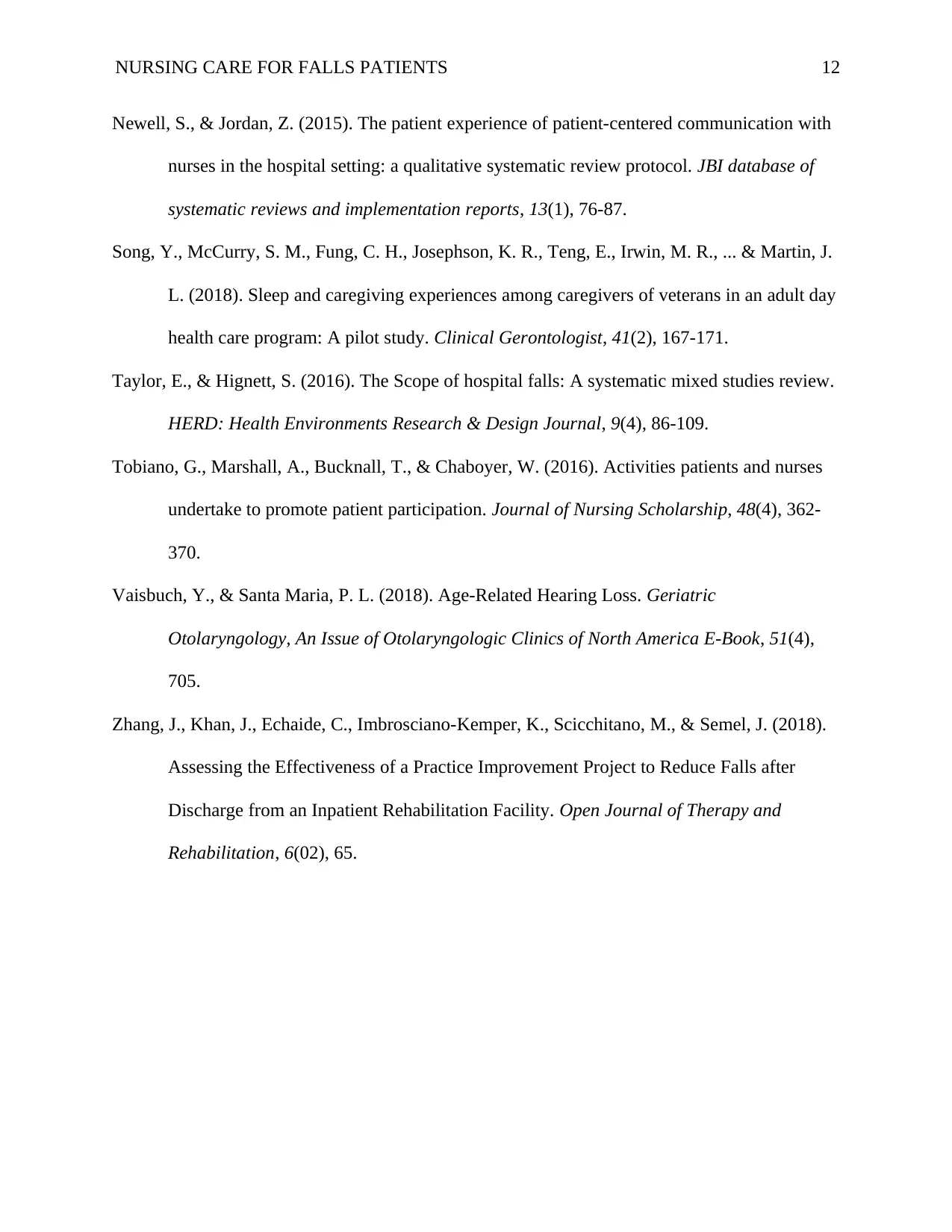
NURSING CARE FOR FALLS PATIENTS 12
Newell, S., & Jordan, Z. (2015). The patient experience of patient-centered communication with
nurses in the hospital setting: a qualitative systematic review protocol. JBI database of
systematic reviews and implementation reports, 13(1), 76-87.
Song, Y., McCurry, S. M., Fung, C. H., Josephson, K. R., Teng, E., Irwin, M. R., ... & Martin, J.
L. (2018). Sleep and caregiving experiences among caregivers of veterans in an adult day
health care program: A pilot study. Clinical Gerontologist, 41(2), 167-171.
Taylor, E., & Hignett, S. (2016). The Scope of hospital falls: A systematic mixed studies review.
HERD: Health Environments Research & Design Journal, 9(4), 86-109.
Tobiano, G., Marshall, A., Bucknall, T., & Chaboyer, W. (2016). Activities patients and nurses
undertake to promote patient participation. Journal of Nursing Scholarship, 48(4), 362-
370.
Vaisbuch, Y., & Santa Maria, P. L. (2018). Age-Related Hearing Loss. Geriatric
Otolaryngology, An Issue of Otolaryngologic Clinics of North America E-Book, 51(4),
705.
Zhang, J., Khan, J., Echaide, C., Imbrosciano-Kemper, K., Scicchitano, M., & Semel, J. (2018).
Assessing the Effectiveness of a Practice Improvement Project to Reduce Falls after
Discharge from an Inpatient Rehabilitation Facility. Open Journal of Therapy and
Rehabilitation, 6(02), 65.
Newell, S., & Jordan, Z. (2015). The patient experience of patient-centered communication with
nurses in the hospital setting: a qualitative systematic review protocol. JBI database of
systematic reviews and implementation reports, 13(1), 76-87.
Song, Y., McCurry, S. M., Fung, C. H., Josephson, K. R., Teng, E., Irwin, M. R., ... & Martin, J.
L. (2018). Sleep and caregiving experiences among caregivers of veterans in an adult day
health care program: A pilot study. Clinical Gerontologist, 41(2), 167-171.
Taylor, E., & Hignett, S. (2016). The Scope of hospital falls: A systematic mixed studies review.
HERD: Health Environments Research & Design Journal, 9(4), 86-109.
Tobiano, G., Marshall, A., Bucknall, T., & Chaboyer, W. (2016). Activities patients and nurses
undertake to promote patient participation. Journal of Nursing Scholarship, 48(4), 362-
370.
Vaisbuch, Y., & Santa Maria, P. L. (2018). Age-Related Hearing Loss. Geriatric
Otolaryngology, An Issue of Otolaryngologic Clinics of North America E-Book, 51(4),
705.
Zhang, J., Khan, J., Echaide, C., Imbrosciano-Kemper, K., Scicchitano, M., & Semel, J. (2018).
Assessing the Effectiveness of a Practice Improvement Project to Reduce Falls after
Discharge from an Inpatient Rehabilitation Facility. Open Journal of Therapy and
Rehabilitation, 6(02), 65.
1 out of 12
Related Documents
Your All-in-One AI-Powered Toolkit for Academic Success.
+13062052269
info@desklib.com
Available 24*7 on WhatsApp / Email
![[object Object]](/_next/static/media/star-bottom.7253800d.svg)
Unlock your academic potential
© 2024 | Zucol Services PVT LTD | All rights reserved.





